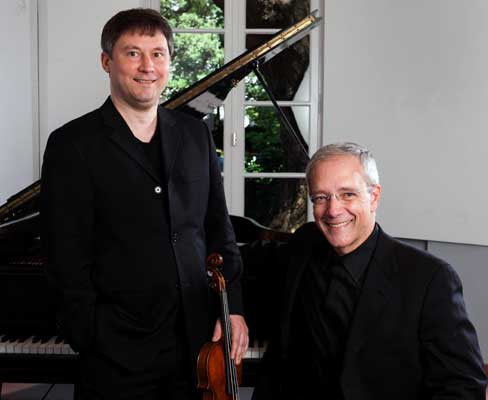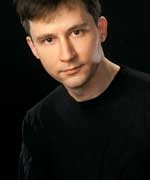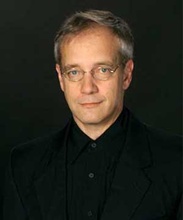
CONCERT II
Sunday, September 22, 2013, 3:00 p.m.
Old Capitol Museum Senate Chamber (map)
Wolfgang David, violin (Vienna)
David Gompper, piano (University of Iowa)
|| download program ||
Program
| Nuance, for solo violin (2012) | David GOMPPER (b 1954) |
|
| Violin Sonata No. 1 in F minor, Op. 80 (1938-46) I. Andante assai II. Allegro brusco III. Andante IV. Allegrissimo - Andante assai, come prima |
Sergei PROKOFIEV (1891-1953) |
|
| — Intermission — | ||
| Ikona for violin and piano (2008) | David GOMPPER | |
| Dikhthas, for violin and piano (1979) | Iannis XENAKIS (1922-2001) |
Performers
Wolfgang David and David Gompper met in 2000, when Wolfgang was on a concert tour of the US. They began to work together as a performer and composer, which resulted in eleven works composed by David Gompper especially written for Wolfgang David, including a Violin Concerto, recently performed by Wolfgang and the Royal Philharmonic Orchestra and recorded for the NAXOS label. As Laurence Vittes of Gramophone writes, "their working relationship is as close and meaningful as Brahms had with Joachim." In 2002 both musicians were invited to perform together as a violin & piano duo in Moscow. Encouraged by this success, they have since presented over 100 concerts, touring throughout the United States and a number of countries in Europe. While their repertoire includes traditional works for this instrumentation, the main focus is a combination of late romantic, standard 20th century and contemporary compositions written especially for them. Three CDs of the duo are available: two on Albany and one on VDE-Gallo.

In the space of a few short years, Wolfgang David has ensconced himself on the international stage, both as a recitalist, and as a guest soloist with many leading orchestras such as the Royal Philharmonic Orchestra, Vienna Radio Symphony Orchestra, Johannesburg Philharmonic Orchestra, Berne Symphony Orchestra, New York Virtuosi etc.
He has been well received by the press — the Washington Post wrote that he "scaled the heights of musicmaking" and The Strad described his playing "as emotionally wide-ranging as one could hope for".
Admitted to the University for Music in Vienna at the age of eight, David studied there for many years with Rainer Küchl, the concertmaster of the Vienna Philharmonic Orchestra. Later he continued his studies at the Musikhochschule in Cologne with Igor Ozim and with Yfrah Neaman at the Guildhall School of Music in London.
The winner of many competitions and prizes, David has performed in major halls such as Konzerthaus and Musikverein Hall in Vienna, Carnegie Hall in New York, Cerritos Center in Los Angeles, the Wigmore Hall in London, Victoria Hall in Geneva, and Philharmonie in Cologne.
Highlights of his career included concerts at the Great Assembly Hall of the United Nations in New York in the presence of Secretary General Kofi Annan, and a concert in Bangkok, given for the Queen of Thailand.
Besides focusing on the traditional main repertoire, Wolfgang David also enjoys collaborating with a number of living composers, such as David Gompper, Noel Zahler, Ching-chu Hu, Joseph Dangerfield, Rainer Bischof, Jeremy Dale Roberts, John Allemeier, etc. He has commissioned, premiered, and recorded works specially written for him.
Wolfgang David performs on a violin built in 1715 by Carlo Bergonzi, Cremona, on exclusive loan to him from the Austrian National Bank.
Wolfgang David has recorded a CD with the Royal Philharmonic Orchestra under the baton of Emmanuel Siffert and three albums with the American pianist David Gompper. Another CD with the Royal Philharmonic Orchestra was released on the NAXOS label in April 2011.

David Gompper has lived and worked professionally as a pianist, a conductor, and a composer in New York, San Diego, London, Nigeria, Michigan, Texas and Iowa. He studied at the Royal College of Music in London with Jeremy Dale Roberts, Humphrey Searle and pianist Phyllis Sellick. After teaching in Nigeria, he received his doctorate at the University of Michigan, taught at the University of Texas, Arlington, and since 1991 has been Professor of Composition and Director of the Center for New Music at the University of Iowa. In 2002-2003 Gompper was in Russia as a Fulbright Scholar, teaching, performing and conducting at the Moscow Conservatory. In 2009 he received an Academy Award from the American Academy of Arts and Letters in New York City.
Gompper's compositions have been performed in such venues as Carnegie, Lincoln Center and Merkin Halls (New York), Wigmore Hall (London), Konzerthaus (Vienna) and the Bolshoi Hall (Moscow). Wolfgang David and the Royal Philharmonic Orchestra recently recorded his Violin Concerto for a Naxos CD. His song cycle The Animals, based on the poetry of Marvin Bell, was released on an Albany disc last June. His Double Concerto, written for Wolfgang David, violin and Timothy Gill, violoncello and Principal of the Royal Philharmonic Orchestra, was premiered last March 2013. This past June he completed a 28' song cycle for soprano and string quartet on texts by Marvin Bell. At the moment he is finishing a work for clarinet and piano as well as a Clarinet Concerto for Michael Norsworthy and BMOP (Boston Music Orchestra Project), Gil Rose, director. He is also completing a Cello Concerto for Timothy Gill for a premiere in April 2014.
Program Notes
David GOMPPER
Nuance for solo violin
is based on a simple descending melody heard in the opening bars. The three-part form explores timbral resources of the instrument through an extended series of character developments. Written in London in January 2012, it has undergone a number of expansions and a "filling out". Very much in my mind was the application of the ratio 1.414 (the square root of 2), the same portion found in many of Bach's works.
Ikona for violin and piano
is a contemplation of a 19th-century Russian icon of St. Nicholas. Three elements are present in the iconic rendering: a square (book of the Gospels), a triangle (created from the crosses of his stole) and three circles (in which the figures of the saint, Christ and Mary appear nimbated). The main motive is derived from three layers of pitch matrices, revealed through a "window" created by the triangle. The 36x36 matrix is itself based on collections of trichords (3x3). Although popularized in western myth as Santa Claus, St. Nicholas was known for his generosity to children, justice for the oppressed, and fight to support the Doctrine of the Trinity at the Council of Nicaea. Hence, the all-pervasive number 3. The work, in three sections, not only follows in general ways the scansion of the Lords Prayer, in Russian, but musically renders three ideas: the linear (the word), the vertical (space), and the connection between the two in the way Eastern Orthodox Christian sign the cross (up, down, right, left).
Sergei PROKOFIEV
Violin Sonata No. 1 in F minor, Op. 80
Prokofiev himself described the Violin Sonata No. 1 as follows:
In mood it is more serious than the Second [Sonata]. The first movement, Andante assai, is severe in character and is a kind of extended introduction to the second movement, a sonata allegro, which is vigorous and turbulent, but has a broad second theme. The third movement is slow, gentle, and tender. The finale is fast and written in complicated rhythm.
Throughout the work, there are additional musical elements that are descriptive and visual. For instance, the last section of the first movement should sound "like the wind in a graveyard," and the same material returns at the very end of the work. David Oistrakh and Lev Oborin gave the premiere performance in October 1946.
Iannis XENAKIS
Dikhthas, for violin and piano
was written for the Italian violinist Salvatore Accardo and Bruno Canino, and is, according to the composer, "like a personage made up of two natures…a dual entity (dikhthas)". The opening gesture in the piano, made up of five independent lines, an elaborate arborescence that expands outward before descending into the very lowest register, is followed by a strongly articulated but static series of very wide double stops in the violin. Such lengthy highly defined sections against shorter passages of contrasting material and interjections help to define the overall formal design of the work. And it is those sustained elements — notes, chords and various pitch collections — that help to provide strong aural anchors that enrichen the perceptual experience of the music.